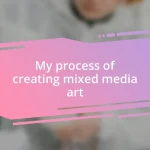Key takeaways:
- Art is subjective; personal experiences and backgrounds significantly influence how individuals relate to and interpret artistic expressions.
- Emotional responses to art vary widely, illustrating how personal history and context can shape feelings derived from different art forms.
- Engaging in art discussions fosters open-mindedness, allowing for appreciation of diverse perspectives and enriching overall understanding of the artwork.

Understanding the subjectivity of art
When I first stood in front of a Jackson Pollock painting, I was struck by how chaotic yet compelling it was. I realized then that art not only reflects the artist’s intent but also resonates with our personal experiences. What might seem like a random splash of paint to some can evoke a deep emotional response in others, illustrating just how varied our interpretations can be.
Have you ever watched a movie that moved you to tears while your friend was completely indifferent? That’s the beauty of subjectivity in art; our unique backgrounds shape the way we perceive and connect with creative work. I often think about how my love for vibrant colors stems from my childhood surrounded by nature. For someone else, a black-and-white piece might spark nostalgia, reminding them of a pivotal moment in their life.
Art invites us into a conversation that’s deeply personal. It makes me ponder how each brushstroke or note in a song carries untold stories—stories that resonate differently depending on who’s experiencing them. Isn’t it fascinating how the same piece can create such contrasting feelings? This interplay between creator and audience is what makes art endlessly captivating.

Emotional responses to artistic expression
Emotional responses to art can vary dramatically from person to person. I recall an instance when I attended a contemporary art exhibition. One painting elicited laughter from some viewers while others were visibly upset. This dichotomy fascinated me; it highlighted how individual life experiences shape our emotional reactions to art. Even a piece meant to provoke thought can result in laughter or sorrow, depending on the viewer’s personal story.
Reflecting on music, I often revisit a particular song that profoundly resonates with me. Each time I hear it, I’m taken back to a moment in my life filled with both joy and sadness. It makes me wonder, how can a few notes trigger such strong memories? This illustrates that music, like all forms of artistic expression, has the power to evoke emotions tied to specific experiences. Isn’t it intriguing that one song can mean something entirely different to someone else?
When exploring emotional responses to art, I’m always drawn back to the power of abstraction. For example, remember the first time you encountered an abstract sculpture? To some, it may seem like a jumbled mess, while others might find harmony in its form. This duality reflects the vast spectrum of human emotions and encourages us to delve deeper into understanding our emotional landscapes.
| Art Form | Emotional Response |
|---|---|
| Painting | Can provoke joy or sadness based on personal history |
| Music | Triggers memories and associated emotions |
| Sculpture | Evokes varied interpretations based on viewer perception |

Evaluating art through diverse perspectives
When I think about evaluating art, I’m often reminded of a recent visit to a community art fair. Each booth showcased unique talents and cultural narratives, and I was struck by how differently each piece spoke to the viewers. Some people found solace in soft landscapes, while others were captivated by gritty urban scenes. This variety made me realize that our individual perspectives—and the stories we bring with us—shape the impact of art on our lives in profound ways.
- Cultural Background: An artist’s heritage can add layers of meaning to their work that only some viewers might fully appreciate.
- Personal Experiences: A piece might resonate with someone based on a similar life event, while another may see it as just an aesthetic choice.
- Context: The environment in which we encounter art plays a role; viewing pieces in a gallery versus an outdoor setting can influence our engagement with them.
- Emotional State: Our mood at the moment of viewing can drastically alter our interpretation; a piece that feels heavy one day might seem lighter on another.
I recall discussing a vibrant mural with a friend who felt it reflected joy and hope. Meanwhile, I saw elements of struggle and conflict intertwined in the same colors. It was enlightening to realize that even our emotional states can color the way we perceive art. This rich tapestry of viewpoints not only broadens our understanding but also deepens our appreciation of different artistic expressions. Each conversation about a piece expands its meaning; isn’t that a beautiful aspect of art?

Balancing critique and appreciation
Finding the right balance between critique and appreciation in art can be a nuanced dance. I remember once critiquing a friend’s painting, where I suggested she explore bolder colors. Although my intention was to help, she felt disheartened. It made me reflect on how critiques can sometimes overshadow the joy that art brings. How do we express our opinions without dampening the original intent behind a piece?
As I’ve navigated various art discussions, I’ve learned that appreciation can exist alongside critique. During a gallery opening, I heard someone passionately praise a piece while simultaneously critiquing its execution. It struck me: we can recognize flaws yet still hold admiration for the emotion or message conveyed. It poses an interesting question—can we truly understand a work of art only through a lens of admiration, or do critiques deepen our appreciation?
I often believe that sharing my thoughts constructively enriches the conversation around art. For instance, I once attended a film festival where I loved a particular short film’s story but found its pacing off. Voicing that opinion sparked a lively discussion about storytelling techniques, ultimately enhancing everyone’s appreciation of the film. Isn’t it fascinating how critique and appreciation can intertwine to create a richer understanding of art?

Encouraging open-mindedness in art discussions
Engaging in art discussions is an incredible opportunity to exercise open-mindedness. I recall a debate about a contemporary sculpture that left me puzzled. A friend praised its innovation, while I struggled to find the significance in its forms. This difference in opinion encouraged me to explore beyond my initial perception. It’s interesting how viewing art through someone else’s lens can reveal layers of meaning I hadn’t considered.
In my experience, listening actively to diverse interpretations fosters a richer dialogue. Once, during a virtual artist talk, attendees shared thoughts on a thought-provoking photograph. Each perspective unveiled an unexpected element—identity, vulnerability, and resilience were all up for grabs. It made me question: how often do we close ourselves off to fresh insights? This openness not only enhances our understanding but also connects us more profoundly to the artist’s intent.
I often think that art discussions should feel like a shared journey rather than a competition of ideas. At an informal drop-in art critique, I found myself surrounded by passionate voices, each one painting a different picture of the same artwork. As we navigated through our interpretations, I realized that the beauty of art lies not just in the piece itself but in the rich tapestry of thoughts and emotions it inspires. How liberating is it to know that no single viewpoint holds the absolute truth?














